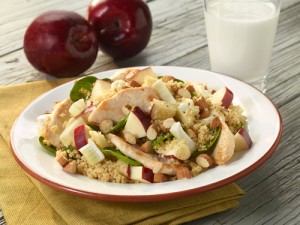Let Fruit and Veggies Help Keep Your Sugar Under Control
November is National Diabetes Month. In recent years, we’ve seen an increase in the numbers of people becoming affected by this serious disease and, even more concerning, the age of onset of those impacted by Type 2 diabetes is lower than ever before. Part of the problem, according to medical experts, is an increase in obesity and a lack of physical activity, both risk factors for Type 2 diabetes. While Type 1 (juvenile) diabetes (when the pancrease ceases to produce insulin) is not preventable and has nothing to do with diet or lifestyle, managing it is very similar to Type 2 diabetes–it involves a healthy diet and regular exercise.
According to the American Diabetes Association, a healthy diet should consist of vegetables, fruit, lean protein, whole grains and low-fat or fat-free dairy. In fact, they have compiled a list of Diabetes Superfoods. Any guesses on what mainly makes up this list? You got it–fruit and veggies!
- Beans
- Dark Green Leafy Vegetables
- Citrus Fruit
- Sweet Potatoes
- Berries
- Tomatoes
- Fish High in Omega-3 Fatty Acids
- Whole Grains
- Nuts
- Fat-Free Milk and Yogurt
One reason these items make the superfoods list is that they are ranked low on the glycemic index, which measures how carbohydrate containing foods can affect your blood glucose. Foods with a high glycemic index will impact your blood glucose more than those with a low glycemic index. It’s important to recognize the difference. A great example is if you’re looking for an afternoon snack and you reach for a candy bar. This has a high glycemic index and will send your blood glucose soaring. Ever notice how you’ll get that “burst” of energy quickly and then kind of “crash” a little while later? That burst of energy isn’t sustained. Compare that with a snack like nuts and fruit, which has fiber, protein and carbohydrates. This is much lower on the glycemic index and it takes your body longer to process it. It provides you energy without sending your glucose levels soaring (and then crashing quickly).
As the wife of a Type 1 diabetic, I’ve had to be aware of carbohydrates and how they affect my husband’s sugar. The benefit of this is that by cooking healthy, it helps to keep the rest of our family in check as well. Honestly, it’s really not that hard to do …I find it’s easiest if I follow the MyPlate guidelines and try to fill half our plates with fruit and veggies at each meal. The remainder of the plate I fill with lean protein, whole grains and low-fat dairy.
Fruits & Veggies–More Matters has some featured healthy plate recipes that can help get you started like this Apple, Fennel and Chicken Salad with Couscous. Sweet and savory is the perfect way to describe the flavor of this dish. The lemon balsamic vinaigrette is perfect finish to this salad.

Easy Oven Packet Tilapia with Pears and Carnival Roasted Potatoes are a healthy addition to your dinner menu. Red potatoes, green beans, bell pepper, onion and Roma tomato make up half your plate.

I love these Fiesta Frescada Lettuce Wraps and Bellafina Boats! This is such a creative and fun way to add more veggies to your plate. This recipe calls for using tilapia filets, but I’ve also substituted shrimp in mine. The southwestern spices go perfectly with the veggies and seafood.

Even if you or someone in your household isn’t diabetic, it’s never a bad idea to start following these healthy guidelines, especially if you’ve got young children in your home.
See all posts


